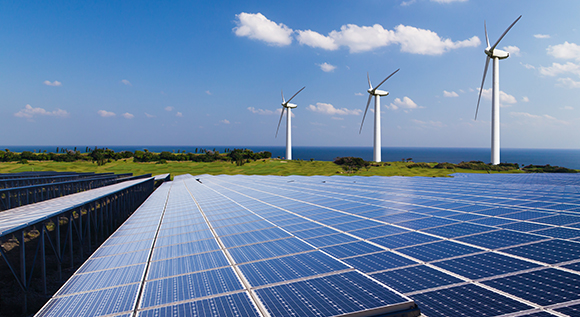2017 World Energy Outlook: Renewables making headway around the world
Renewables are becoming more affordable, and they are playing an ever more important role around the world. However, as stated in the latest version of the World Energy Outlook, global efforts are currently not enough – more needs to be done in order for countries to meet the goals set out in the Paris Agreement.
 © iStock.com/imacoconut
© iStock.com/imacoconut
The International Energy Agency’s latest edition of the World Energy Outlook (WEO) clearly shows that the global energy system is facing fundamental change.
The main reason for this is that the price of renewable energy technologies keeps falling. The cost of PV installations and wind turbines has dropped by 70 percent and 25 percent respectively since 2010. As a result, there has been a massive expansion of renewables right across the globe. For many countries, renewables now are the most affordable option when it comes to building new generation facilities.
If the energy policies that the countries have announced are implemented by 2040, the IEA forecasts that renewables will account for two thirds of global investment in electricity generation. This would lead to renewables accounting for 40 percent of total electricity generation. PV is seen as the most important low-carbon source of energy around the world, with China and India massively expanding their PV capacities. In the European Union, wind farms are set to dominate the energy market from 2030.
Renewables, together with natural gas, will play a key role for meeting the rising global energy demand. Based on the New Policies Scenario, the IEA expects global energy demand to increase by around 30 percent by 2040. Some of the energy efficiency measures taken can already be seen – without them, the expected rise in global energy demand would be twice as high.
However, the IEA also highlights in its report that the policies that countries have already announced will not be enough to stop energy-related carbon emissions from rising further or to prevent climate change from having serious consequences. The IEA has therefore developed an additional scenario – the Sustainable Development Scenario – setting out which measures need to be taken in order make an adequate contribution to stabilising the climate by 2040. This would also help make considerable progress in terms of providing access to energy in the developing countries and in terms of combatting air pollution. The Sustainable Development Scenario would require investment of $69 billion compared with $60 billion for the New Policies Scenario. The decisive factor, according to the WEO, is to ensure an adequate policy framework and adequate price signals. Fossil fuel subsidies that encourage wasteful consumption need to be reduced. In 2016, these subsidies amounted to around $260 billion – this is twice as high as the funding provided for the expansion of renewable energy.
The WEO also analyses current sectoral and regional changes. Its conclusion: the share of electricity in total energy consumption is growing around the world.
It will reach almost one quarter by 2040. In 2016, global investment in electricity was almost as high as investment in oil products. Some 40 percent of the global rise in final energy consumption is due to a rising demand for electricity, boosted by an increased use of industrial electric motors, electronic devices and air-conditioning systems. The areas of heat generation and transport also increasingly rely on electricity. The IEA expects that by 2040, the number of electric cars will have reached 280 million, up from 2 million today.
China has recently taken decisions geared towards making the country’s energy supply cleaner and more efficient. This will greatly drive forward the global development towards decarbonising the energy supply, the IEA writes. This expansion of clean energy by the world’s largest energy consumer is sending a strong message to others. One third of all new wind power and PV capacities will be created in China. By 2040, China will also be importing around 280 billion cubic metres of natural gas, making the country one of the largest players in the global gas trade.
In the United States, too, the oil and gas sector will continue to change. The cost-effective mining of the new shale gas and shale oil resources means that the US has already become a net exporter of gas and that by 2020, it could also become a net exporter of oil. As a result, international trade flows could continue to change, whilst investment in the energy-intensive sectors in North America could increase.

